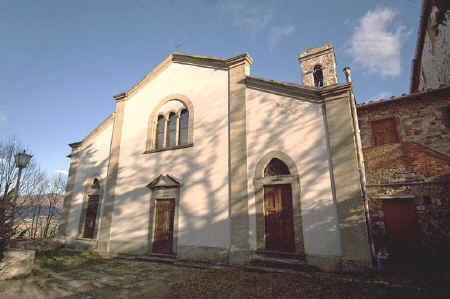// ITALIANO//

Il paese di Montefioralle è probabilmente uno dei più antichi del Chianti e ancora oggi è racchiuso nelle mura originali. Inizialmente, erano costituite da una cinta doppia, ma ora ci sono delle case a occupare lo spazio tra le strutture originali. Le mura avevano forma ottagonale, con quattro cancelli ed è ancora possibile vedere alcune modifiche loro apportate. Durante il Medioevo, era uno dei centri militari e amministrativi più grandi della zona. Le prime notizie di un insediamento risalgono al 1085 e fanno riferimento alle famiglie Ricasoli, Benci, Gherardini e Vespucci. Nel 1325, fu saccheggiato da Castruccio Castracani.

Nel punto più alto del villaggio, è possibile visitare la chiesa di S. Stefano, ricostruita nel XVII e XVIII secolo. Nella navata principale ci sono diverse opera d’arte, soprattutto una preziosa opera di XIII secolo che raffigura la Vergine Maria con il Bambin Gesù e due angeli, attribuita al Maestro di Bagnano o al Maestro di Greve. Nel presbiterio, c’è la “Trinità e i quattro Santi”, un'opera anonima che mostra le influenze di Neri di Bicci e Andrea del Castagno. A sinistra, vi è un dipinto della Vergine Maria con Giovanni Battista e Santo Stefano, un’opera della scuola di Lorenzo Monaco (inizio del XV secolo). Fino al 1630, il nome del villaggio era Monteficalle. Dal XVIII secolo, l'importanza di questo villaggio è stata superata da quella di Greve in Chianti, originariamente un semplice mercato locale.
//ENGLISH//
The village of Montefioralle is probably one of the most ancient in Chianti and is still today enclosed within its original walls. These were initially two circuits but houses now fill the space between the original structures. The walls were octagonal in outline, with four gates, modifications of which still exist. During the Middle Ages it was one of the largest military and administrative centres of the area. The first notice of the settlement is from 1085. It belonged to the families Ricasoli, Benci, Gherardini and Vespucci. In 1325 it was sacked by Castruccio Castracani.
At the highest point of the village, the church of S. Stefano, rebuilt in the 17 C and 18 C, may be visited. In the wide nave are a number of works of art, notably a precious work of the 13 C depicting the Virgin Mary with the baby Jesus and two angels, attributed to the Master of Bagnano or to the Maestro of Greve. In the presbytery is the "Trinity and four Saints", an anonymous work showing the influences of Neri di Bicci and Andrea del Castagno. On the left is a painting of the Virgin Mary with the John the Baptist and Saint Stephen, a work of the school of Lorenzo Monaco (beginning of the 15 C). Until 1630, the name of the village was Monteficalle. Since the 18 C, this fortified village has been overtaken in importance by Greve in Chianti, originally a simply local market.

Communal dinner, held once a year in Montefioralle